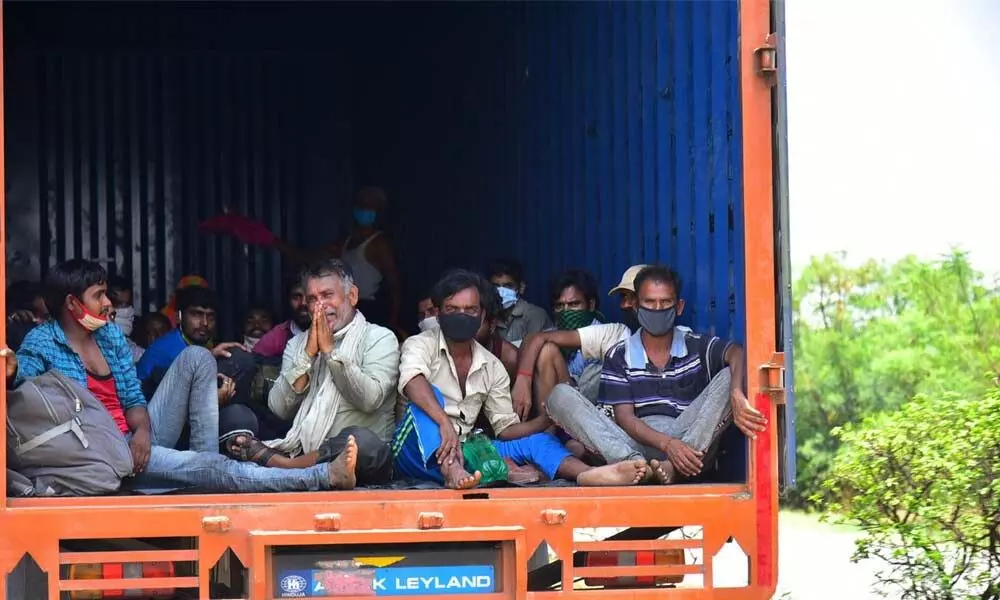Migration in India: A shift in agenda
 migrant labourers
migrant labourersThere is growing concern worldwide that climate change will drive largescale human migration across geographies and borders
There is growing concern worldwide that climate change will drive largescale human migration across geographies and borders. The rhetoric, however, requires scrutiny. The actual causes and consequences of migration are complex and dynamic and therefore, often little understood and misreported, if not reduced to sensational headlines.
Humans have always migrated. Often their movements were influenced by climatic and environmental factors. Migration out of Africa over 60,000 years ago helped our species "increase greatly on Earth and multiply in it" as some creation myths have put it.
Push and pull factors, including environmental and climatic ones, have possibly influenced this great movement. The lesson from prehistory is that we are mobile, and climate and migration nexus is not as straightforward as tabloids would have us believe.
Since the 1980s and even before, projections and policy papers have highlighted the issue of climate-related migration. However, the numbers they gave almost never added up. Migration is a rather complex phenomenon.
As editors of a highly influential special issue of the journal Global Environmental Change argued close to a decade ago: "Migration is an important social, economic and cultural phenomenon that somehow has been overlooked in the field of human dimensions of environmental change. In an interconnected and mobile world, migration would seem to be an increasingly important response to stress, shock and uncertainty."
The question therefore is not whether climate change causes migration (as it certainly does), but to what extent and in what ways.
Contrary to what we see in films and read in some newspapers, it is not one dramatic climate event that triggers mass migration. People move back and forth across different spans of time and space.
The new buzzword about such movements is "mobilities" that encompass "large-scale movements of people, objects, capital and information across the world, as well as the more local processes of daily transportation and movement through public space".
It expands the scope of migration, usually understood as movement "away from his or her place of usual residence, whether within a country or across an international border, temporarily or permanently, and for a variety of reasons".
Attributing migration or changes in mobilities directly to climatic events is difficult as migration is one of the choices that people exercise to improve their lives and livelihoods and can have many motivations and limiting factors.
In the face of climate change, migration can be a long-term adaptation or short-term coping strategy. For someone living in the Sundarbans that frequently gets affected by seasonal floods, storms and riverbank erosion, mobility could be a life and death question, or an escape route from poverty.
Research shows people's response strategies often include internal and external migration. A person affected by a storm surge might evacuate to a cyclone shelter, live on an embankment, make day trips for work in a village where farms are less affected by a recent storm, migrate temporarily to a small town and sell toys, or decide to settle in a big city where he or she finds a job. Migration is increasingly seen as a solution, not a problem.
Extreme weather events and disasters have led to significant population displacement in the past. Changing frequency and intensity of extreme events and their sudden onset will increase the challenges, risks, and geographical spread of such displacement as recent research shows.
For instance, 2018 floods in Kerala after extreme rains during the monsoon season led to temporary displacement of a million people. That year, about 2.67 million people were displaced due to disasters from across the country. The trend of extreme rain and flood continued in 2019 as well.
Metros such as Mumbai are repeatedly facing floods amid a trend of extreme rain, part of what leading scientists see as the impact of climate change. On the flip side, erratic rain or lack of rain could lead to massive crop failures, food shortages and subsequent migration.
Changes in weather could disrupt nature-based livelihoods such as pastoralism, herding, farming, fishing, hunting and gathering, and subsequently lead to migration.
The way people perceive and respond to such threats to their livelihoods and lifestyles are culturally mediated. They could live locally and adapt or move en masse to a new place perceived to be better and safer or take a more calculated approach by sending a family member or two to work elsewhere and rebuild their livelihoods back home with remittances.
Mobility options open up numerous possibilities and innovations. However, from an environmental justice point of view, people who end up on the frontiers of such changes often have negligible carbon footprints. Many of them use just a small wood stove and a couple of oil lamps, walk to work and row their boats.
The Fifth Assessment Report (AR5) of the United Nations Intergovernmental Panel on Climate Change (IPCC) has shown a few general trends on how climate change influences people's mobility patterns.
First, there is an increase in urban migration leading to horizontal expansion and sprawl of cities. Since many vulnerable groups do not have enough resources to pay for their migration in the face of disasters and extreme weather, they could get trapped in vulnerable locations.
Scientists say it could be a double whammy for many as urban migrants living in shanties might be exposed to further risks such as floods, heat waves and storm surges in coastal cities. There are also indirect threats that the urban poor faces. This includes food insecurity due to a spike in food prices and cost of accommodations.
Second, extreme weather events could cause sudden spurts of migration—lasting a few days to a few months. In such cases, people tend to return to their places of origin once the event is over and its impacts are mitigated. Third, long-term changes such as sea level rise, coastal erosion, salinity of water resources and loss of farm productivity could lead to permanent migration. Sea level changes have especially been projected to lead to permanent migration.
IPCC's latest report, The Ocean and Cryosphere in a Changing Climate, adds a further dimension to this saga of mobility. Coasts are home to a tenth of the global population, highlands are home to another tenth and small island states a hundredth.
Available evidence shows three clear trends. One, climate change leads to new migrations. Though it is hard to predict these movements, there are indications of their direction, causes and imponderables such as tipping points.
Second, as science offers new insights into the impacts of climate change, there is cause for concern in regions such as low-lying coasts, islands, highlands and urban areas. Third, as all scientific reports say loud and clear, we need to act now.
First of all, policies need to be based on evidence. There is ample evidence for certain trends in climatic and environmental changes and their impacts that include changing patterns of human mobility. So policies need to squarely address these. Countries have done such transformative policy shifts as studies show.
We can no longer pretend — as some policymakers and scientists do — that there is no data. There is data and it is their job to generate more reliable data.
Second, the operative term in climate change migration is mobility. People move in many directions, back and forth, across time and space. The mythical static, homogenous world never existed — it has always been a melting pot. The wise thing is to acknowledge this fact and anticipate, plan and manage mobilities as much as possible.
It is migrant labourers who build, run and sustain cities. Yet, they are the ones always get pushed towards the city's peripheries. Cities need to be migrant-friendly and changing demographic shifts should influence urban planning.
Third, boundary walls, in literal and figurative senses, are not the solution to climate change-related migration. Instead, bridges work better. "Border securitisation in current global, regional and national politics has infiltrated science policy.
It is biasing public discourse and scientific and policy debates, despite the paucity of supporting evidence," as leading scientists have written in a recent issue of Nature Climate Change. The shrill rhetoric against migration must stop.
(The author is Research Fellow, School of Global Studies, University of Sussex, UK. Courtesy: Down To Earth)


















